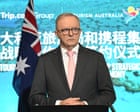
In recent days, various regions across the globe have witnessed significant political and military developments that continue to shape the international landscape. From the strategic decisions of Australia in the Pacific, to the persistent conflict in Ukraine, and the deployment of military forces to Eastern Europe, these events underscore the complex dynamics of global diplomacy and regional security.
The Australian government, led by Prime Minister Anthony Albanese, has reaffirmed its stance regarding potential involvement in international conflicts, notably a hypothetical conflict concerning Taiwan. Speaking in response to reports that the United States had sought assurances from Australia concerning its response to potential future conflicts in the Indo-Pacific region involving China, Australian Defense Industry Minister Pat Conroy made it clear that Australia will not commit in advance to participating in such conflicts. Prime Minister Albanese emphasized the importance of maintaining peace and stability in the region, aligning with the U.S. policy of “strategic ambiguity” concerning military actions over Taiwan. Such a decision highlights Australia’s careful navigation between supporting its long-time ally, the United States, and managing diplomatic relations with China.
Meanwhile, in Eastern Europe, Ukraine faces ongoing challenges from the protracted conflict with Russia. The current climate suggests that Ukraine must brace itself for a future absent of ceasefire prospects. Analysts and former government officials from Ukraine advocate for recalibrated military and diplomatic strategies that recognize Russian President Vladimir Putin’s apparent disinterest in pursuing peace. This strategic realism calls for Ukraine to strategically counter Russian advances while fostering possible diplomatic engagements that focus on long-term stabilization.
Across the border, Russia’s military tactics have been adapting to the realities of the battlefield in Ukraine. Recent shifts indicate a decrease in the deployment of armored vehicles, with an increased reliance on lighter, civilian vehicles like motorcycles and scooters. This adjustment reflects tactical responses to both resource constraints and the fast-paced nature of current military engagements. These changes are part of a broader strategy aimed at maintaining effectiveness in a rapidly evolving conflict environment.
In the Middle East, Syria has seen a resurgence in violence, particularly in areas predominantly inhabited by the Druze community. Recent clashes resulted in significant casualties, signaling the ongoing volatility in a region struggling to escape the cycles of conflict that have continued despite previous efforts at reconciliation and peacebuilding. The incidents represent the first major confrontations since earlier escalations in the spring, which similarly brought tragic losses amid clashes between Syrian security forces and local factions.
In a show of international solidarity and cooperative defense initiatives, around 200 military personnel from Portugal’s army and navy have been deployed to Romania as part of NATO’s collective security efforts. This seven-week operational commitment reflects Portugal’s dedication to contributing to NATO’s objectives and providing support for regional stability in Eastern Europe. This deployment is emblematic of broader European engagement in addressing security concerns in the face of geopolitical tensions, particularly those influenced by the situations in Russia and Ukraine.
Collectively, these developments underscore the interconnected nature of global diplomacy and the balancing act required to maintain peace and security across different regions. As nations carefully strategize their roles on the international stage, they remain committed to fostering dialogue, supporting allies, and pursuing peace where possible, even in times of uncertainty and change.
Source: {link}
